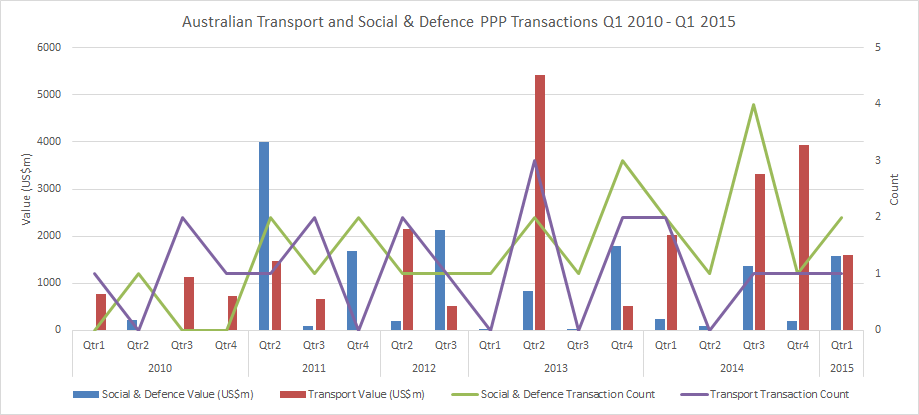Q1 2015 League Table Analysis: Australian PPP
IJGlobal’s Q1 league tables for 2015 show Australia’s PPP sector as a consistently strong area of activity for sponsors in the Asia Pacific market. But this steady sector faces questions heading into Q2 2015.
Transport and social and defence PPP transactions in Australia have been consistent since Q1 2010, with at least one or two deals successfully closing every quarter. Values are also reasonably consistent, with most quarters seeing at least $1 billion worth of business concluded.
In Q1 2014, IJGlobal data shows four PPP transactions across all sectors reaching financial close in Australia, with a total transaction value of $2.27 billion. For Q1 2015, the total number of deals in Australia decreased by one to three. But the total transaction values rose by around $800 million to $3.05 billion.
With PPP projects across Asia reaching financial close in Q1 2014 generating a total of $3.9 billion, and in Q1 2015 a total value of $5 billion, Australia is, regionally, the PPP powerhouse.
And globally the market is significant. The Australian PPP market accounted for the largest global transport transaction for Q1 2015 – the $1.6 billion Sydney Light Rail PPP.
However, recent political changes at the Australian state level may end up shaking strong sponsor confidence in Australian PPPs moving forward into Q2 2015 and beyond.
One notable example of this is the $4.6 billion East West Link PPP, which reached financial close in October 2014.
But, since then, the election of a new government in the Victoria state has seen the project effectively scrapped and the sponsors chasing compensation. The Victoria government recently agreed to pay the project’s developers the $263 million they have already spent on the project, but with the caveat that no further compensation is coming. Considering that Australia has previously had a stable PPP market, the repercussions of the cancellation of East West Link are as yet unclear.
But it would not be a surprise to see volumes and transaction numbers drop over the next few quarters as a result.
Request a Demo
Interested in IJGlobal? Request a demo to discuss a trial with a member of our team. Talk to the team to explore the value of our asset and transaction databases, our market-leading news, league tables and much more.


